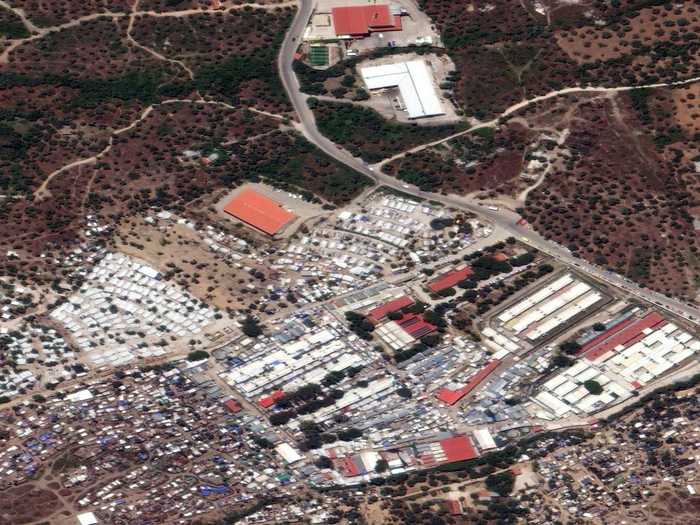
A general view of Moria refugee camp located on island of Lesbos is seen after a fire broke out leaving thousands of people without shelters, in Lesbos, Greece on September 10, 2020.Aggelos Barai/Anadolu Agency via Getty Images
The overcrowded Moria refugee camp in Greece was set ablaze on Tuesday night displacing the more than 12,000 migrants being housed there.
Greek authorities said the fire was most likely started by camp residents who were "dissatisfied" with lockdown measures implemented to curb the spread of the coronavirus, after 35 people tested positive for COVID-19 this week, CNN reported.
Non-governmental organizations told the Guardian that the situation is dire and more tragedy is unfolding as the camp still burns.
Annie Petros, head coordinator of the charity Becky's Bathhouse, told the Guardian that police prevented her from taking injured people to the hospital while she was driving them away from the fire.
"When we saw there was a fire we drove as fast as we could with water to the camp, intending to take sick people to hospital. I can't describe properly the scene we saw. There were streams of people, thousands of them, walking away from the camp. They were totally silent, terrified and traumatized, walking through thick smoke and the awful smell of burning plastic," Petros told the outlet.

Source: CNN

"We now have 12,000 people with no shelter, homeless on the main road. I have been called just now by the army, they want to get food to people and masks, sanitization," Omar Alshakal, a former refugee and founder of Refugees4Refugees, told the Guardian.

CNN reported that 35 people in the camp tested positive for COVID-19 this week.
Authorities believe the cause of the fire was likely those in the camp who were upset by the lockdown measures.

"I recognize the difficult conditions. However, nothing can become an alibi for violent reactions to health checks. And, much more, for riots of this magnitude," Mitsotakis said, according to CNN. "The situation in Moria cannot continue because it is a matter of public health, humanity, and national security at the same time."

"There are still too many people there," Ylva Johansson, the European commissioner for migration told The New York Times this week.
She called the conditions in camp "unacceptable."

The New York Times reported that surrounding areas were also impacted and only a medical facility and a small number of tents were spared on Tuesday.

Some had to walk miles to the other villages to get access to basic supplies like food and water, Al Jazeera reported.
"Our home burned, my shoes burned, we don't have food, no water," Valencia, an eight-year-old Congolese girl said.
Al Jazeera said Valencia was walking barefoot when she approach a Reuters reporter and asked for a biscuit because she was hungry.

Source: BBC

Source: BBC

The Greek ferry Blue Star Chios, which can accommodate 1,000 people has already docked at a port 60 miles away from the main island. Two naval vessels will also be sent to hold some who are displaced, the BBC reported.
 I spent $2,000 for 7 nights in a 179-square-foot room on one of the world's largest cruise ships. Take a look inside my cabin.
I spent $2,000 for 7 nights in a 179-square-foot room on one of the world's largest cruise ships. Take a look inside my cabin. Colon cancer rates are rising in young people. If you have two symptoms you should get a colonoscopy, a GI oncologist says.
Colon cancer rates are rising in young people. If you have two symptoms you should get a colonoscopy, a GI oncologist says. Saudi Arabia wants China to help fund its struggling $500 billion Neom megaproject. Investors may not be too excited.
Saudi Arabia wants China to help fund its struggling $500 billion Neom megaproject. Investors may not be too excited. Catan adds climate change to the latest edition of the world-famous board game
Catan adds climate change to the latest edition of the world-famous board game
 Tired of blatant misinformation in the media? This video game can help you and your family fight fake news!
Tired of blatant misinformation in the media? This video game can help you and your family fight fake news!
 Tired of blatant misinformation in the media? This video game can help you and your family fight fake news!
Tired of blatant misinformation in the media? This video game can help you and your family fight fake news!

Copyright © 2024. Times Internet Limited. All rights reserved.For reprint rights. Times Syndication Service.